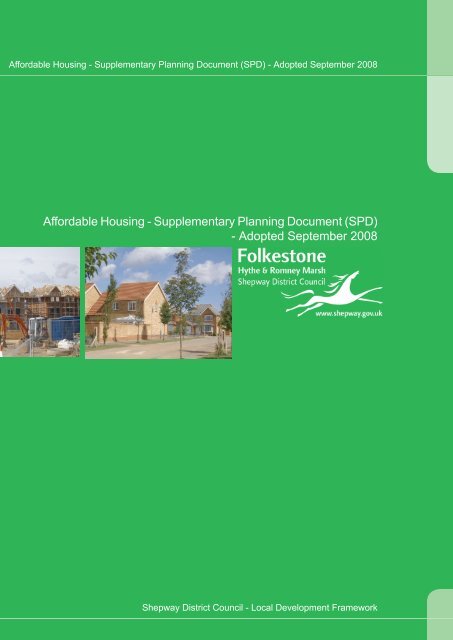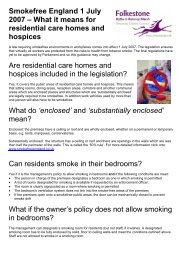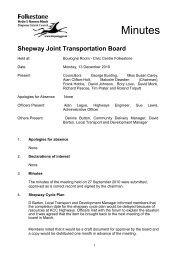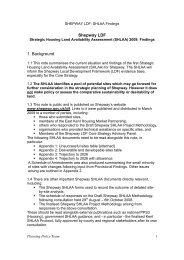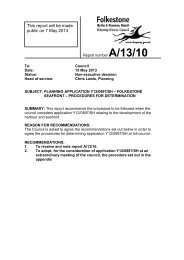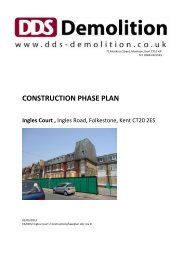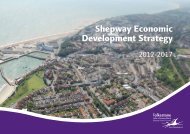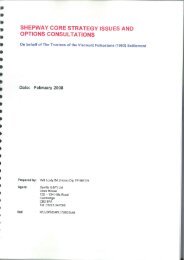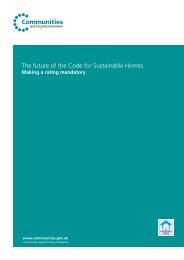Affordable Housing - Shepway District Council
Affordable Housing - Shepway District Council
Affordable Housing - Shepway District Council
- No tags were found...
You also want an ePaper? Increase the reach of your titles
YUMPU automatically turns print PDFs into web optimized ePapers that Google loves.
<strong>Affordable</strong> <strong>Housing</strong> - Supplementary Planning Document (SPD) - Adopted September 2008<strong>Affordable</strong> <strong>Housing</strong> - Supplementary Planning Document (SPD)- Adopted September 2008<strong>Shepway</strong> <strong>District</strong> <strong>Council</strong> - Local Development Framework
<strong>Affordable</strong> <strong>Housing</strong> - Supplementary Planning Document (SPD) - Adopted September 20081 Introduction2 Planning Context3 <strong>Affordable</strong> <strong>Housing</strong> Provision4 How Provision will be calculated5 The Nature of Provision6 Size and Type of Dwelling to be provided7 Management and Administration8 Design Issues9 Ensuring Delivery10 Rural exception sites11 Monitoring5791113151721232527AppendicesAppendix 1 - PoliciesAppendix 2 - DefinitionsAppendix 3 - Useful contacts293537<strong>Shepway</strong> <strong>District</strong> <strong>Council</strong> - Local Development Framework
<strong>Affordable</strong> <strong>Housing</strong> - Supplementary Planning Document (SPD) - Adopted September 2008<strong>Shepway</strong> <strong>District</strong> <strong>Council</strong> - Local Development Framework
<strong>Affordable</strong> <strong>Housing</strong> - Supplementary Planning Document (SPD) - Adopted September 20081 Introduction1.1 Policy HO4 of the <strong>Shepway</strong> <strong>District</strong> Local Plan Review (adopted March 2006),seeks the provision of affordable housing on all new housing developments of15 or more dwellings, or over 0.5 hectares in area. The purpose of thisSupplementary Planning Document (SPD), is to provide more detailed advicefor applicants for planning permission for new housing development, and alsofor the information of the wider public, on how <strong>Shepway</strong> <strong>District</strong> <strong>Council</strong> willapply the policy. This includes the council’s preferred methods for securing thedelivery of affordable housing.1.2 This SPD adopted on 17th September 2008 provides information on theexpectations of the council on the issues of provision, management and controlof the affordable housing units, and identifies how the local planning authoritywill deal with matters of dwelling type size and design, and tenure.<strong>Shepway</strong> <strong>District</strong> <strong>Council</strong> - Local Development Framework5
<strong>Affordable</strong> <strong>Housing</strong> - Supplementary Planning Document (SPD) - Adopted September 20086<strong>Shepway</strong> <strong>District</strong> <strong>Council</strong> - Local Development Framework
<strong>Affordable</strong> <strong>Housing</strong> - Supplementary Planning Document (SPD) - Adopted September 20082 Planning Context2.1 The provision of affordable housing to meet the needs of households who wouldotherwise be unable to afford homes adequate for their needs is a central partof National Government Policy. Planning Policy Statement 3 (PPS3), publishedNovember 2006, particularly reflects the Government’s commitment to improvingthe affordability and supply of housing. <strong>Affordable</strong> housing is presented asintegral to the government's key policy of ensuring that everyone has theopportunity of living in a decent home. <strong>Affordable</strong> housing is defined as includingsocial rented and intermediate housing. Paragraph 27 of PPS3 states that 'TheGovernment is committed to providing high quality housing for people who areunable to access or afford market housing, for example, vulnerable people andkey workers'. The key relevant paragraphs of PPS3 are set out in Appendix 1.2.2 In November 2006 the Government also published a policy statement entitled“Delivering <strong>Affordable</strong> <strong>Housing</strong>”, which should be read in conjunction with PPS3.This statement is aimed at achieving delivery of more high quality affordablehousing within mixed sustainable communities. Local authorities are encouragedto make use of all the ‘tools’ available to them to reach this aim.2.3 The South East Regional Plan is currently being prepared and an Examinationin Public was held in 2007. The report of the Panel was published on 29thAugust 2007. The Plan provides guidance until 2026 and once adopted willsupersede the Kent and Medway Structure Plan. The submitted South EastPlan sets a target of 5,100 dwellings in <strong>Shepway</strong> over the period 2006 to 2026of which 30% should be affordable. The Panel did not recommend any changesto either the total provision in <strong>Shepway</strong> or the affordable housing target. Thepolicy relevant to affordable housing is set out in full in Appendix 12.4 The Kent and Medway Structure Plan was adopted in July 2006. It sets outstrategic policy requirements for the provision of housing quantities in each ofthe local authority areas in Kent. Policy HP7 requires Local DevelopmentDocument policies to be drawn up to identify the proportion of the strategichousing provision that should be met by affordable housing on the basis ofdistrict housing needs assessments. Policy HP7 <strong>Affordable</strong> <strong>Housing</strong> Provisionand Policy HP8 <strong>Affordable</strong> <strong>Housing</strong> on rural Exception sites, are set out in fullin Appendix 1.2.5 The <strong>Shepway</strong> <strong>District</strong> Local Plan Review was adopted in March 2006. As aLocal Plan adopted in accordance with the Town and Country Planning(Transitional Arrangements) (England) Regulations 2004, the policies in thePlan are automatically ‘saved’ for at least three years from the date of adoption,or until replaced by new Local Development Documents as part of the Local<strong>Shepway</strong> <strong>District</strong> <strong>Council</strong> - Local Development Framework7
<strong>Affordable</strong> <strong>Housing</strong> - Supplementary Planning Document (SPD) - Adopted September 2008Development Framework. This SPD seeks only to provide guidance and adviceon the implementation of these policies and does not include any new policymaterial.2.6 Policies HO4, HO5 and HO6 of the Local Plan Review (2006) are relevant.Policy HO4 states that the <strong>District</strong> Planning Authority will seek to negotiate for30% affordable housing provision on all new housing developments of 15dwellings or more (or over 0.5 hectares). Policy HO5 seeks a mix of dwellingtypes to suit a variety of needs or demands on all new housing developments,including those at the lower end of the market. Policy HO6 sets out the criteriafor the provision of affordable housing within or adjoining villages as an exceptionto normal housing policies – these are often called ‘rural exception sites’. Thesepolicies are set out in full in Appendix 1.8<strong>Shepway</strong> <strong>District</strong> <strong>Council</strong> - Local Development Framework
<strong>Affordable</strong> <strong>Housing</strong> - Supplementary Planning Document (SPD) - Adopted September 20083 <strong>Affordable</strong> <strong>Housing</strong> Provision3.1 A district-wide <strong>Housing</strong> Needs Survey was carried out in 2003. This identifieda need for affordable housing of over 900 units per annum, or over 7,000 unitsover the Plan period. (Source: <strong>Shepway</strong> <strong>Housing</strong> Needs Survey 2003 – DavidCouttie Associates Ltd). The Local Plan Review (2006) did not consider thatsuch a target was economically deliverable or sustainable and sets a lessertarget of 500 homes to be provided during the Plan period. It is not expectedthat all this housing will be delivered by the development of sites allocated withinthe Plan; other means of creating affordable homes such as the conversion oflarger houses or the bringing back into use of vacant units, are also referredto.3.2 House price increases in recent years have contributed to a situation wheremiddle earning households, as well as those with the lowest incomes, are beingincreasingly priced out of the local housing market. The figures used in the2003 <strong>Housing</strong> Needs Survey require re-evaluation due to house price rises,increased wage levels and inflation in the intervening period. Nevertheless,the figures provide a clear assessment of the situation as at the date of thesurvey, which informed the creation of Policy HO4. The Survey indicated thatany household with an annual income below £22,000 to £31,000, dependingon location within the district, would struggle financially to buy the smallest,acceptable quality units in the local housing market. For example, based on95% mortgage and a 3x gross income lending ratio, incomes of £22,000 to£24,000 would be needed to buy a one bedroom flat in Folkestone, (the cheapestlocation). For a two bedroom terraced house, annual incomes ranging from£27,000 (Folkestone), to £30,000 (New Romney) and £31,000 (Hawkinge andPaddlesworth) would be required. However, the <strong>Housing</strong> Needs Survey alsoindicated that only 16% of newly forming households had an annual income ofmore than £23,000.3.3 The Survey also indicated that affordability issues restricted access to theprivate rented sector with some 75% of those seeking housing unable to afforda rent of more than £70 a week. This equated (based on a rent at 25% of grossincome) to an annual income requirement of £13,500 to rent a one bedroomflat in Folkestone rising to £17,500 in Hythe and £19,000 in New Romney. Anincome of £20,000 would have been necessary to rent a two bedroom terracehouse in Folkestone whereas 83% of newly forming households have an annualincome of less than this figure. Current indicators show that the affordabilitygap within the local housing market has continued to grow.3.4 <strong>Affordable</strong> housing is defined in the Local Plan Review (2006) as ‘<strong>Housing</strong> forpeople who are not able to afford to purchase or rent adequate accommodationon the open market without subsidy’.<strong>Shepway</strong> <strong>District</strong> <strong>Council</strong> - Local Development Framework9
<strong>Affordable</strong> <strong>Housing</strong> - Supplementary Planning Document (SPD) - Adopted September 200810<strong>Shepway</strong> <strong>District</strong> <strong>Council</strong> - Local Development Framework
<strong>Affordable</strong> <strong>Housing</strong> - Supplementary Planning Document (SPD) - Adopted September 20084 How Provision will be calculated4.1 In accordance with policy HO4 of the <strong>Shepway</strong> <strong>District</strong> Local Plan Review(2006), affordable housing will be sought on all new housing developments for15 or more dwellings or on sites with a gross area of 0.5 hectares or more.Policy BE11 of the Plan states that a net density of at least 30 dwellings to thehectare will be sought in new residential developments.4.2 The council is committed to ensuring that affordable housing is achieved on allrelevant sites. Therefore, where it appears that a site is proposed to bedeveloped at a density lower than 30 dwellings per hectare in order to avoidhaving to provide affordable housing, planning permission will be refused.When a planning application is received the Planning Authority will assess anappropriate density for the particular site in accordance with Policies BE11 andBE12 and if this is 15 or more dwellings then a need for affordable housing willbe generated.4.3 Where a site is divided into smaller areas the council will treat each parcel asa ‘phase’ of the development of the whole site, and the affordable housingrequirement will be apportioned to each part of the site accordingly. The councilwill be alert to any proposals to create artificial boundaries within sites in orderto frustrate the operation of Policy HO4.4.4 Policy HO4 applies to development, redevelopment and conversions of existingbuildings, where new residential units are created. In calculating the need foraffordable housing provision, the council will apply the gross number of newdwellings created, and not the net increase. For example, where one house isdemolished and replaced by 15 new units, the affordable housing requirementwill be calculated on the basis of the provision of 15 new units, not on the netincrease of 14, which would fall below the threshold. The number of dwellingsrequired to meet the 30% provision will be rounded up to the nearest wholefigure.4.5 Where developments have taken place which fall below the threshold foraffordable homes, subsequent applications for the sub-division of units whichwould increase the number of units to above the threshold, will result in a needfor affordable housing being triggered. Any new units above the threshold willtherefore be expected to be affordable units.4.6 Provision of affordable housing should be made on site and integrated withinthe development (see also paragraphs 7.11 to 7.15). This will result in sociallyinclusive and sustainable communities. Only in exceptional circumstances willit be acceptable for provision to be made off site. Applicants will need to showgood planning reasons why it is not be practical or desirable to provide on siteprovision.<strong>Shepway</strong> <strong>District</strong> <strong>Council</strong> - Local Development Framework11
<strong>Affordable</strong> <strong>Housing</strong> - Supplementary Planning Document (SPD) - Adopted September 20084.7 If it is accepted by the council that an off site provision of affordable housing isappropriate for a particular development, the following contributions will besought, either:-(i) Full provision of the number of affordable units generated by thedevelopment, on a suitable alternative site; or(ii) A cash contribution towards the provision of affordable units on a siteto be determined by the council and its Registered Social Landlord (RSL)partners; or(iii) A cash contribution to an established scheme that maybe operatedby the council for the restoration and renovation of existing housing stock.4.8 The amount of the cash contribution payment due under (ii) will be calculatedas set out in Section 7. A higher contribution is expected from provision of offsite units to reflect the benefit to the developer of using the whole site for openmarket housing. This will also help to achieve a more even distribution ofaffordable housing throughout the district in relation to general housing, thusleading to more integrated communities. For example if a site is developed for30 units, the affordable housing contribution would be for 9 units leading to 21open market and 9 affordable (30% of 30). If however the whole site is developedfor open market housing – 30 units, the off site contribution should be for morethan 9 units to reflect the increased numbers of open market units - e.g. 30open market and 12 affordable (30% of 30 plus 30% of 9, therefore 9 + 3 = 12,giving a total of 42 dwellings).12<strong>Shepway</strong> <strong>District</strong> <strong>Council</strong> - Local Development Framework
<strong>Affordable</strong> <strong>Housing</strong> - Supplementary Planning Document (SPD) - Adopted September 20085 The Nature of Provision5.1 Local Plan Review (2006) Policy HO4 requires provision of affordable housingto be dispersed on the site and not concentrated in one location. There aremany examples of housing developments in the UK where affordable unitshave been successfully integrated within wider open market developments suchthat there is no obvious distinction between the two types of provision. ThePoundbury development in Dorset is one such example. The integration ofaffordable units within a development has benefits in creating mixed communitiesand avoids the disadvantages, and socially undesirable consequences, ofconcentrations of one type of housing or tenure type. The council does notaccept that, in properly designed schemes, affordable housing and markethousing cannot make good neighbours.Tenure types5.2 There are a number of different forms of affordable housing. Annex B of PPS3defines affordable housing as including both “social rented and intermediatehousing, provided to specified eligible households whose needs are not metby the market.” All affordable housing provided should meet two key criteria.It should:-“Meet the needs of eligible households including availability at a cost lowenough for them to afford, determined with regard to local incomes andlocal house prices andinclude provisions for the home to be retained for future eligible households;orIf these restrictions are lifted, for any subsidy to be recycled for alternativeaffordable housing provision.”5.3 The <strong>Council</strong> recognises the following types of affordable housing:-(i) Social Rented <strong>Housing</strong>- This is generally owned and managed by aRegistered Social landlord (RSL), and rented to a household at anaffordable rent, which is set in accordance with <strong>Housing</strong> Corporationguidance. Social Rented <strong>Housing</strong> should be available in perpetuity topersons in housing need (subject to the exception where tenants have theright to acquire).(ii) Intermediate <strong>Housing</strong>- This is housing provided at prices and rentsabove those of Social Rented housing but below market price or rents.<strong>Shepway</strong> <strong>District</strong> <strong>Council</strong> - Local Development Framework13
<strong>Affordable</strong> <strong>Housing</strong> - Supplementary Planning Document (SPD) - Adopted September 2008(ii)(a) Shared Ownership (equity) <strong>Housing</strong> is partly sold to a householdand partly rented to them by an RSL. Households can buy an increasingequity share of the dwelling but until full equity is achieved the RSL willretain control over the unit. Shared ownership housing should be availablein perpetuity to persons in housing need, or where staircasing to fullownership is achieved, the receipts from staircasing will be recycled byRSLs into the provision of new affordable homes.(ii)(b) Intermediate Rented- These are homes which are provided at rentlevels above those of social rented housing but below private rents. Keyworker rented accommodation usually falls within this category. This wouldonly be considered as affordable housing where the homes remain availableto eligible households within the specified category in perpetuity, or thesubsidy is transferred to provide substitute affordable housing.(iii) Community Land Trusts (CLTs)-These are community basedorganisations that enable local communities to own and manage local landassets, such as affordable housing, for the benefit of their local community.The <strong>Council</strong> will apply policy HO4 to any affordable housing developed bythis means, to ensure that it will remain affordable and available to personsin housing need in perpetuity.Low Cost Market <strong>Housing</strong>5.4 This category consists of housing which is provided at the lower end of thehousing market, or dwellings which are sold at below the market value or at thelower end of the property market at a discount, but where there is no control torestrict sale and resale so that the ‘low cost’ is retained in perpetuity. Suchdwellings are not considered to be an acceptable form of affordable housingwithin the terms of Policy HO4 unless the sale and subsequent re-sales of theunits is controlled to ensure that the units will remain available to persons inhousing need in perpetuity, or the subsidy is transferred to provide substituteaffordable housing. Low cost market housing may however, be specificallyidentified as part of the wider mix of housing needed within the district, as aresult of the <strong>Housing</strong> Market Assessment (see paragraph 10.2).14<strong>Shepway</strong> <strong>District</strong> <strong>Council</strong> - Local Development Framework
<strong>Affordable</strong> <strong>Housing</strong> - Supplementary Planning Document (SPD) - Adopted September 20086 Size and Type of Dwelling to be provided6.1 The mix of affordable homes to be provided on each site will be assessed inrelation to the most up to date information on housing need in the locality. Thestarting point will be the <strong>Housing</strong> Needs Survey carried out in 2003, or any suchlater study as may have been carried out, for example a Town or Parish Local<strong>Housing</strong> Needs survey, or a <strong>Housing</strong> Market Assessment (see paragraphs 11.2and 11.3). This will be supplemented by information from the <strong>Housing</strong> WaitingList and on specific identified local needs such as homeless persons, keyworkers and specially adapted homes.6.2 The size and type of dwelling which should be provided should ideally reflectthe most urgent and acute housing need in the locality. There may becircumstances however, where the location or nature of the site, results in anassessment for a particular type of unit. For example, a town centre locationwith restricted outside space and likely to be subject to some late night noisedisturbance, would be potentially unsuitable for the elderly or families butacceptable for young and/or single persons who prefer a more livelyenvironment.6.3 The <strong>Council</strong>’s <strong>Housing</strong> Strategy Manager will be consulted on any planningapplication where a requirement for affordable housing is generated inaccordance with Policy HO4, to identify a preferred mix of dwelling types andsizes. Normally the council will expect a tenure split of 60% social rented and40 % intermediate housing, although local circumstances and conditions mayenable an alternative ratio. See also paragraph 7.5.6.4 Key Worker accommodation is intended to provide housing for particular publicsector occupations where there are particular local recruitment and retentiondifficulties due to problems of finding affordable accommodation. Examples ofkey workers are teachers, nurses and health care workers, social workers andpolice officers. Schemes specifically to house key workers may be provided onsites developed by RSLs but unless a specific need for key worker housing hasbeen identified, and can be verified in the area, the <strong>Council</strong> will not accept keyworker housing as a substitute for the provision of affordable housing underPolicy HO4.6.5 Provision for disabled and mobility impaired. The council will give considerationto the provision of a proportion of the affordable housing requirement in theform of specialist adapted units suitable for wheelchair users and other supportedhousing. Any enquiries or negotiations on the provision of such units should bedirected to the <strong>Council</strong>'s <strong>Housing</strong> Strategy Manager. All new housing shouldbe accessible for visiting by people with physical or mobility impairments. Whereaffordable homes are provided a target of 20% of the provision meeting thelifetime homes standard, will be sought by the council.<strong>Shepway</strong> <strong>District</strong> <strong>Council</strong> - Local Development Framework15
<strong>Affordable</strong> <strong>Housing</strong> - Supplementary Planning Document (SPD) - Adopted September 20086.6 Any site suitable for housing should be considered suitable for providingaffordable housing in accordance with Policy HO4.16<strong>Shepway</strong> <strong>District</strong> <strong>Council</strong> - Local Development Framework
<strong>Affordable</strong> <strong>Housing</strong> - Supplementary Planning Document (SPD) - Adopted September 20087 Management and Administration7.1 <strong>Affordable</strong> housing providers will be required to enter into a lettings andoccupancy agreement with <strong>Shepway</strong> <strong>District</strong> <strong>Council</strong> covering the details ofhow the homes will be allocated and occupied. This will be based on localhousing need.7.2 The council will normally require the affordable homes to be provided inpartnership with one of its RSL partners as detailed in Section 9.2 below. Thecouncil will consider proposals for alternative affordable housing providers, butwill need to be satisfied by these and approve a detailed statement ofarrangements. This statement will need to include descriptions of thearrangements for :Costs of the homes to residentsManagement and maintenance arrangementsResident involvement and satisfactionFinancial sustainabilityEnvironmental managementContribution to meeting local housing needsCommunity cohesion7.3 It is expected that any affordable housing provided through a developmentwill not be subsidised by Social <strong>Housing</strong> Grant or other public subsidy. Thisshould ensure that there is no additional drain on affordable housing resourcesand should allow the land value and cost of development to be factored intothe negotiations between the developer and the Registered Social Landlord(RSL), in the knowledge that there will not be subsidy available. Otherwise,public money that would go towards one project would be redirected to anotherand would not achieve the objective of increasing the overall supply of localneeds homes.7.4 <strong>Affordable</strong> rented homes should be provided at <strong>Housing</strong> Corporation TargetRent levels, and shared equity homes should be affordable to people earningon and around the average household income for the <strong>Shepway</strong> <strong>District</strong> (asdetermined by the council). The cost of intermediate rented homes should berestricted to affordable rented levels, plus 40% of the difference betweenaffordable rented and market rents in the district.<strong>Shepway</strong> <strong>District</strong> <strong>Council</strong> - Local Development Framework17
<strong>Affordable</strong> <strong>Housing</strong> - Supplementary Planning Document (SPD) - Adopted September 20087.5 The council will encourage discussions with developers and RSLs at the outsetof any development process. It will provide a pre-scheme brief setting out thepreferred arrangements for the provision of local needs housing and a draftSection 106 agreement or draft conditions, using standard clauses. Thisapproach will assist developers and RSLs in evaluating the costs of provisionof the affordable housing requirement and help to ensure that negotiations areresolved as quickly as possible. Developers will be required to pay the legaland administrative costs of negotiating and setting up agreements or conditions.7.6 Specific costs and contributions will need to be negotiated between developersand RSLs for the transfer of local needs homes or land. The agreement will berequired to enable the delivery of the agreed local needs homes at the costlimits set out in paragraphs 7.3 and 7.4, and should be in a form approved bythe council.7.7 Where affordable housing is provided within an overall market housingdevelopment, any service or management charges payable (including rentcharges and ground rents) should be restricted. This will ensure that the unitsremain affordable to occupiers. As a guide, service/management charges shouldnot be greater than the prevailing level of charges that can be met throughhousing benefit.7.8 Financial viability- The council expects developers to take account of thepolicy requirement for affordable housing on any qualifying site, when negotiatingthe purchase price. The council will not accept a purchase price of the siteabove the land value as a justification for reducing or removing the affordablehousing requirement.7.9 Where applicants/developers seek to show that 30% affordable housing cannotbe delivered for economic viability reasons, they will be expected to provide afinancial appraisal to support the claim when the planning application issubmitted. The following list identifies the main factors which would need to beaddressed:-(i) site or building acquisition cost(ii) construction costs including abnormal site development costs(iii) fees and other on-costs(iv) projected sales prices for open market dwellings(v) gross margin(vi) other costs such as developer contributions18<strong>Shepway</strong> <strong>District</strong> <strong>Council</strong> - Local Development Framework
<strong>Affordable</strong> <strong>Housing</strong> - Supplementary Planning Document (SPD) - Adopted September 2008(vii) anticipated receipts from the provision of affordable housing7.10 In these exceptional circumstances the council may agree to a reduced provisionof affordable housing on the site, or some form of public subsidy to ensure thataffordable housing can be delivered on the site. The council may takeindependent advice on the submitted financial appraisal.7.11 Off site provision of affordable housing will only be acceptable where theapplicant/developer can demonstrate to the satisfaction of the council that thereare genuine and insurmountable reasons why on site provision cannot beachieved satisfactorily. The desire to increase sales income by marketing adevelopment of wholly private housing, will not be accepted as justification. Thedevelopment of affordable homes off site will only be acceptable where thecouncil is satisfied that the provision will be deliverable in terms of the availabilityof a site and a RSL partner.7.12 Commuted Sums- In exceptional circumstances the council may decide thatit is more appropriate for the developer to make a cash contribution for theprovision of local needs housing on another site in the locality. This contributionis known as a commuted sum payment. It is proposed that where a commutedsum is appropriate, its value will be calculated on the basis of the formula setout below. However it should be noted that it is the council’s preferred optionto secure affordable housing within the development site. This will maximisethe opportunity for affordable housing development, encourage tenure diversityand create inclusive mixed communities within new developments.7.13 The contribution is intended to cover the actual costs of finding an alternativesite and constructing affordable homes as set out in paragraph 4.8. Thealternative scheme will also be required to provide an appropriate mix of size,tenure and type of homes (see Section 6 above). The council will calculate therequired contribution, taking into account the purchase of suitable land, thecosts of construction and appropriate on-costs. The calculation will also takeinto account the maximum contribution that an RSL could make towards thedevelopment and still meet the cost limits set out above.7.14 Commuted Sum = Cost of Land + Cost of Contribution (with on-costs) –RSL Contribution7.15 The level of contribution for any site will be based on the above formula. Theeconomics of housing development however, set an absolute limit on the valueof contributions that can be supported by any particular site, and it is unlikelythat developers would be able to proceed on a site if their profit margin fell toolow. It is important to note therefore that contributions towards affordablehousing will impact upon the ability of developers to contribute towards otheranticipated developer contributions towards community infrastructure such as<strong>Shepway</strong> <strong>District</strong> <strong>Council</strong> - Local Development Framework19
<strong>Affordable</strong> <strong>Housing</strong> - Supplementary Planning Document (SPD) - Adopted September 2008education, transport, archaeological investigations and community facilities.The Kent County <strong>Council</strong> Guide to Development Contributions and Provisionof Community Infrastructure will be taken into account when negotiating section106 agreements.7.16 The council may identify a list of priorities for the need for developer contributionsarising as a result of the development of any site. This will take account ofplanning priorities in the locality. Planning obligations will be decided in linewith circular 1/97, Local Plan Review (2006) policy SC1 and in line with sitespecific circumstances.7.17 It is anticipated that the costs of the financial demands on developers arisingfrom the need for developer contributions should be taken account of andreflected in lower land values within the district.20<strong>Shepway</strong> <strong>District</strong> <strong>Council</strong> - Local Development Framework
<strong>Affordable</strong> <strong>Housing</strong> - Supplementary Planning Document (SPD) - Adopted September 20088 Design Issues8.1 All new homes provided should meet current <strong>Housing</strong> Corporation SchemeDesign standard or other prevailing standards for affordable housing asdetermined by the government and its agencies.8.2 In February 2008 the Government published amended guidance on the designand construction of sustainable homes (The Code for Sustainable Homessettingthe standard in sustainability for new homes).This aims to drive a ‘stepchange’ in sustainable home building as a way of tackling the levels of carbonemissions created by the use of energy to heat, light and run homes. The Codeuses a sustainability rating to assess performance of homes on a scale of 1*to 6*. The council approved a guidance note in January 2008 on applying theCode in <strong>Shepway</strong> which recommends that all new homes should be expectedto achieve at least a 3* rating. This will be applied to all new private sector andpublic sector housing schemes.8.3 The council wishes to make the best use of the land available for housebuildingwithout leading to over intensive developments offering a poor quality of livingenvironment. All affordable housing provision should achieve a minimum densityof 30 dwellings to the hectare, but within urban areas densities much higherthan this may be achievable without compromising on quality and amenity. Onall sites the council will seek a mix of dwellings in accordance with Policy HO5and require all new developments to have a high standard of layout, designand choice of materials in accordance with Policy BE10.The district councilsupports the Kent Design Guide (which has been adopted by the council as anSPD) and its recommendation.8.4 <strong>Affordable</strong> housing should be fully integrated into the wider development inlocations agreed between the developer and the council. The affordable housingprovided should have essentially the same external design features as themarket housing provided on the site.<strong>Shepway</strong> <strong>District</strong> <strong>Council</strong> - Local Development Framework21
<strong>Affordable</strong> <strong>Housing</strong> - Supplementary Planning Document (SPD) - Adopted September 200822<strong>Shepway</strong> <strong>District</strong> <strong>Council</strong> - Local Development Framework
<strong>Affordable</strong> <strong>Housing</strong> - Supplementary Planning Document (SPD) - Adopted September 20089 Ensuring Delivery9.1 A Section 106 agreement, or appropriate unilateral undertaking, will be requiredfor all planning applications which provide affordable housing, including outlineapplications. The issues which will usually be covered by the agreement are:-(i) the number, size, type and tenure of the affordable units(ii) the location of the affordable units within the development(ii) the timing of the construction and occupation of the affordable units inrelation to the rest of the site.(iii) arrangements for, and timing of, any payments associated with thetransfer of the affordable units and/or land to the managing body (RSL).(iv) RSL details(v) mortgagee in possession clauses9.2 The council works with five preferred partner Registered Social Landlords.These are:-Hyde <strong>Housing</strong> GroupOrbit <strong>Housing</strong> GroupRural <strong>Housing</strong> Trust (rural schemes only)Southern <strong>Housing</strong> GroupTown and Country <strong>Housing</strong> Group9.3 Contact details for RSLs are set out in Appendix 3. The council’s preferredpartners will be reviewed from time to time, so developers are advised to checkcurrent information with the council.<strong>Shepway</strong> <strong>District</strong> <strong>Council</strong> - Local Development Framework23
<strong>Affordable</strong> <strong>Housing</strong> - Supplementary Planning Document (SPD) - Adopted September 200824<strong>Shepway</strong> <strong>District</strong> <strong>Council</strong> - Local Development Framework
<strong>Affordable</strong> <strong>Housing</strong> - Supplementary Planning Document (SPD) - Adopted September 200810 Rural exception sites10.1 Policy HO6 of the <strong>Shepway</strong> <strong>District</strong> Local Plan Review (2006) allows thedevelopment of sites within or adjoining villages for local needs housing, wherethe need has been identified, as an exception to normal policies restrictingdevelopment within rural areas. Such ‘exception sites’ need to be justified inrelation to the criteria set out in the policy, in particular the use of a detailedparish survey or other compelling evidence.10.2 If a local need has been established the site selection process needs to becarried out in consultation with the <strong>District</strong> <strong>Council</strong>’s Planning Officers, the RSLdevelopment partner, and the local Parish/Town <strong>Council</strong>(s). The scale, locationand accessibility of the site should be sensitive to the character of the villageand to the opinions/feelings of the local community. The design of the unitsshould be in keeping with existing local dwellings wherever possible to aidintegration and avoid the appearance of an ‘incongruous’ development imposedon a cohesive settlement. All dwellings provided through this means must beaffordable in perpetuity. Open market housing will not be permitted as a meansof cross subsidising affordable units.<strong>Shepway</strong> <strong>District</strong> <strong>Council</strong> - Local Development Framework25
<strong>Affordable</strong> <strong>Housing</strong> - Supplementary Planning Document (SPD) - Adopted September 200826<strong>Shepway</strong> <strong>District</strong> <strong>Council</strong> - Local Development Framework
<strong>Affordable</strong> <strong>Housing</strong> - Supplementary Planning Document (SPD) - Adopted September 200811 Monitoring11.1 The provision of affordable housing units is and will continue to be monitoredannually as part of the Annual Monitoring Report (AMR), which is required aspart of the Local Development Framework. The report is submitted in Decembereach year covering the period April of the previous calendar year to March ofthe current year. The AMR will be made available on the <strong>District</strong> <strong>Council</strong>'swebsite.11.2 Strategic <strong>Housing</strong> Market Assessments are used for assessing housing needand demand. PPS3 Annex C sets out the requirements for these assessments.Local Authorities are encouraged to use <strong>Housing</strong> Market Assessments as partof the planning policy process, to assess housing need and demand in termsof housing market areas, and to gain an appreciation of the characteristics ofhousing market areas and how they function. It should:-Estimate housing need and demand in terms of affordable and markethousing.Determine how the distribution of need and demand varies across the planarea, for example, as between urban and rural areas.Consider future demographic trends and identify the accommodationrequirements of specific groups such as homeless households, black andminority ethnic groups, first time buyers, disabled people, older people,Gypsies and Travellers and occupational groups such as key workers,student and operational defence personnel.11.3 The council is preparing a joint East Kent <strong>Housing</strong> Market assessment togetherwith Canterbury City <strong>Council</strong>, Dover <strong>District</strong> <strong>Council</strong>, Thanet <strong>District</strong> <strong>Council</strong>,and Swale Borough <strong>Council</strong>. The results of this are expected in summer 2008.The Assessment will provide evidence, updating the findings of the 2003 <strong>Housing</strong>Needs Survey, about the level of affordable housing required, including theneed for different sizes of affordable housing.<strong>Shepway</strong> <strong>District</strong> <strong>Council</strong> - Local Development Framework27
<strong>Affordable</strong> <strong>Housing</strong> - Supplementary Planning Document (SPD) - Adopted September 200828<strong>Shepway</strong> <strong>District</strong> <strong>Council</strong> - Local Development Framework
<strong>Affordable</strong> <strong>Housing</strong> - Supplementary Planning Document (SPD) - Adopted September 2008Appendix 1 - PoliciesPlanning Policy Statement 3<strong>Affordable</strong> <strong>Housing</strong>27. The Government is committed to providing high quality housing for people whoare unable to access or afford market housing, for example, vulnerable people andkey workers as well as helping people make the step from social-rented housing tohome ownership. This section should be read together with the Government’s<strong>Affordable</strong> <strong>Housing</strong> Policy Statement. 18The Government defines affordable housingas including social-rented and intermediate housing.28. In the context of creating mixed communities, Regional Spatial Strategies shouldset out the regional approach to addressing affordable housing needs, including theaffordable housing target for the region and each housing market area.29. In Local Development Documents, Local Planning Authorities should:Set an overall (ie plan-wide) target for the amount of affordable housing to beprovided. The target should reflect the new definition of affordable housing inthis PPS. 19It should also reflect an assessment of the likely economic viabilityof land for housing within the area, taking account of risks to delivery and drawingon informed assessments of the likely levels of finance available for affordablehousing, including public subsidy and the level of developer contribution thatcan reasonably be secured. Local Planning Authorities should aim to ensurethat provision of affordable housing meets the needs of both current and futureoccupiers, taking into account information from the Strategic <strong>Housing</strong> MarketAssessment.Set separate targets for social-rented and intermediate affordable housing whereappropriate. A sufficient supply of intermediate affordable housing can helpaddress the needs of key workers and those seeking to gain a first step on thehousing ladder, reduce the call on social-rented housing, free up existingsocial-rented homes, provide wider choice for households and ensure that siteshave a mix of tenures.Specify the size and type of affordable housing that, in their judgement, is likelyto be needed in particular locations and, where appropriate, on specific sites.This will include considering the findings of the Strategic <strong>Housing</strong> MarketAssessment and any specific requirements, such as the provision of amenityand play space for family housing, and, where relevant, the need to integratethe affordable housing into the existing immediate neighbourhood and widersurrounding area.<strong>Shepway</strong> <strong>District</strong> <strong>Council</strong> - Local Development Framework29
<strong>Affordable</strong> <strong>Housing</strong> - Supplementary Planning Document (SPD) - Adopted September 2008Set out the range of circumstances in which affordable housing will be required.The national indicative minimum site size threshold is 15 dwellings. However,Local Planning Authorities can set lower minimum thresholds, where viable andpracticable, including in rural areas. This could include setting differentproportions of affordable housing to be sought for a series of site-size thresholdsover the plan area. Local Planning Authorities will need to undertake an informedassessment of the economic viability of any thresholds and proportions ofaffordable housing proposed, including their likely impact upon overall levels ofhousing delivery and creating mixed communities. In particular, as the newdefinition of affordable housing excludes low cost market housing, in decidingproportions of affordable housing to be sought in different circumstances, LocalPlanning Authorities should take account of the need to deliver low cost markethousing as part of the overall housing mix.Set out the approach to seeking developer contributions to facilitate the provisionof affordable housing. In seeking developer contributions, the presumption isthat affordable housing will be provided on the application site so that itcontributes towards creating a mix of housing. However, where it can be robustlyjustified, off-site provision or a financial contribution in lieu of on-site provision(of broadly equivalent value) may be accepted as long as the agreed approachcontributes to the creation of mixed communities in the local authority area.30. In providing for affordable housing in rural communities, where opportunities fordelivering affordable housing tend to be more limited, the aim should be to deliverhigh quality housing that contributes to the creation and maintenance of sustainablerural communities in market towns and villages. This requires planning at local andregional level adopting a positive and pro-active approach which is informed byevidence, with clear targets for the delivery of rural affordable housing. Where viableand practical, Local Planning Authorities should consider allocating and releasingsites solely foraffordable housing, including using a Rural Exception Site Policy. This enables smallsites to be used, specifically for affordable housing in small rural communities20 thatwould not normally be used for housing because, for example, they are subject topolicies of restraint.Rural exception sites should only be used for affordable housing in perpetuity. ARural Exception Site policy should seek to address the needs of the local communityby accommodating households who are either current residents or have an existingfamily or employment connection, whilst also ensuring that rural areas continue todevelop as sustainable, mixed, inclusive communities.18 See Delivering <strong>Affordable</strong> <strong>Housing</strong> Policy Statement, Communities and LocalGovernment, November 2006.30<strong>Shepway</strong> <strong>District</strong> <strong>Council</strong> - Local Development Framework
<strong>Affordable</strong> <strong>Housing</strong> - Supplementary Planning Document (SPD) - Adopted September 200819 See new definition at Annex B.-----------------------------------------------------------------------------South East Regional Plan -Policy H4 <strong>Affordable</strong> <strong>Housing</strong>Local Development Documents will contain policies to deliver a substantial increasein the amount of affordable housing in the region, reflecting both this Plan and theRegional <strong>Housing</strong> Strategy. Local Development Documents will set targets for theprovision of affordable housing, taking account of the results of housing need andmarket assessments and having regard to the overall regional target that 25% of allnew housing should be social rented accommodation and 10% other forms ofaffordable housing. Where justified by housing needs assessments, LocalDevelopment Documents should specify the tenure of housing being sought. Therewill be a presumption in favour of on-site affordable housing provision.To help ensure the delivery of affordable housing, Local Development documentswill provide comprehensive policy and guidance on financial viability and the role ofpublic subsidy in the light of guidance from the Regional Assembly and the Regional<strong>Housing</strong> Board.In rural areas, Local Development Documents will promote small scale affordablehousing sites within or well related to settlements, possibly including land whichwould otherwise not be released for development.-----------------------------------------------------------------------Kent and Medway Structure PlanPolicy HP7 <strong>Affordable</strong> <strong>Housing</strong> ProvisionProvision of all affordable housing involving net additions to the housing stock willcontribute to meeting the housing quantities in Policy HP1.Local Development Documents should:<strong>Shepway</strong> <strong>District</strong> <strong>Council</strong> - Local Development Framework31
<strong>Affordable</strong> <strong>Housing</strong> - Supplementary Planning Document (SPD) - Adopted September 2008(a) establish the proportion of strategic housing provisions identified in Policy HP1that should be met by affordable housing on the basis of district housing needsassessments(b) identify the respective contributions planned for shared equity , key worker andother forms of intermediate housing(c) indicate the site size thresholds that will apply to provision of affordable housingand provide indicative targets for the level and composition of the contribution requiredfrom specific sites.Policy HP8 <strong>Affordable</strong> <strong>Housing</strong> on Rural Exception SitesLocal Development Documents should indicate those rural settlements at which theprovision of affordable housing would be acceptable on sites that have not beenallocated for housing but where such development would be justified to meet a provenlocal need.---------------------------------------------------------------------------<strong>Shepway</strong> <strong>District</strong> Local Plan Review (2006)POLICY HO4 <strong>Affordable</strong> <strong>Housing</strong>. In all new housing developments of 15 dwellingsor more (or over 0.5ha) the <strong>District</strong> Planning Authority will seek to negotiate anelement of affordable housing of 30%. Such provision should be retained to meetlong term affordable needs and is subject to market and site conditions. Provisionon individual sites should be dispersed and not be concentrated in one location. Anoverall target of a minimum of 500 homes will be sought across the <strong>District</strong> as awhole.POLICY HO5 On all new housing developments, a mix of dwelling types should beincorporated, to suit a variety of needs or demands including those at the lower endof the market subject to market or site conditions.POLICY HO6 Planning permission will be granted for proposals for local needshousing development within or adjoining villages of a suitable scale and type to meetidentified needs provided that:-(a) The need cannot satisfactorily be met on sites with planning consent for housingor through an allocated site in this Local Plan or from redevelopment, infill orconversion in line with other policies in the Plan.32<strong>Shepway</strong> <strong>District</strong> <strong>Council</strong> - Local Development Framework
<strong>Affordable</strong> <strong>Housing</strong> - Supplementary Planning Document (SPD) - Adopted September 2008(b) The local need has been clearly identified by a detailed parish survey. It may benecessary to take into account the needs in adjacent parishes so as to relatecatchment areas to settlements.(c) There is no satisfactory alternative means of meeting the identified needs.(d) The development has been designed and will be available at a cost capable ofmeeting the identified local need.(e) The site is well related in scale and sitting, to the village and its services and iscapable of development without significant adverse countryside, conservation,environmental or highway safety impact.(f) The proposal does not involve cross subsidy. In allowing local needs housing itwill be necessary to ensure that the subsequent occupancy of the housing iscontrolled, by condition or agreement, so that the accommodation remains availableto meet local needs.Note: In assessing local needs, the requirements of the following groups of peopleresident in the parish of the proposed development, or adjoining parishes, will beconsidered. The requirement for local needs housing will be demonstrated by theinability of households to gain access to accommodation, suited to their needs at anaffordable cost, and within the limits of their disposable income. A parish survey willneed to show that a significant number of households are in this position.(a) Households currently resident in accommodation unsuited to their circumstancesfor physical, medical or social reasons, and which is incapable of being improved.(b) Persons who are dependants of households resident in the parish.(c) Households including persons employed full-time in the parish on other than ashort term basis or who will be taking up such employment, or who provide animportant service requiring them to live locally.(d) Persons who are not currently resident but have retained long standing links withthe local community or who have moved away due to lack of affordable housing.(e) Other cases of local need if considered justified by the <strong>District</strong> Planning Authority.For the purposes of this Policy "resident" is interpreted as three years continuousresidence in the parish or alternatively, any five out of the last ten years.Policy BE11 The <strong>Council</strong> will seek a net density of at least 30 dwellings per hectarein new residential development. Planning permission will not be granted for residentialdevelopment which would cause significant harm to:<strong>Shepway</strong> <strong>District</strong> <strong>Council</strong> - Local Development Framework33
<strong>Affordable</strong> <strong>Housing</strong> - Supplementary Planning Document (SPD) - Adopted September 2008a. the character of the site itself, including the presence of landscape features andany other features of interest;b. the character of the surrounding area.Policy BE12 Planning permission for further residential development within thefollowing Areas of Special Character as defined on the Proposals Map, will not begranted if development will harm the existing character of the area, by reason ofeither a loss of existing vegetation, especially in relation to important skylines; or agreater visual impact of buildings:a. the west end of Folkestone, and Radnor Cliffb. Julian Road/Wilton Road/ Cornwallis Avenue;c. Sunnyside Road/Brewers Hill, Sandgate;d. Hillside Street/North Road, Hythe, and Saltwood;e. Cannongate Road/Cliff Road/ Seabrook Road, Hythe;f. Madeira Road, Littlestone;g. The Oval Dymchurch.Where sites are allocated for development within these areas, proposals will only bepermitted if the design blends in terms of scale, mass and architectural details withthe character of the area.34<strong>Shepway</strong> <strong>District</strong> <strong>Council</strong> - Local Development Framework
<strong>Affordable</strong> <strong>Housing</strong> - Supplementary Planning Document (SPD) - Adopted September 2008Appendix 2 - DefinitionsPPS3 Definitions:-<strong>Affordable</strong> <strong>Housing</strong> includes social rented and intermediate housing, provided tospecified eligible households whose needs are not met by the market. <strong>Affordable</strong>housing should :- meet the needs of eligible households including availability at a cost low enoughfor them to afford, determined with regard to local incomes and local house prices;and- include provisions for:(i) the home to be retained for future eligible households; or(ii) if these restrictions are lifted, for any subsidy to be recycled for alternativeaffordable housing provision.Social Rented housing rented housing owned and managed by local authorities andRSLs, for which guideline target rents are determined through the national rentregime. It may also include rented housing owned or managed by other personsand provided under equivalent rental arrangements to the above, as agreed with thelocal authority or with the <strong>Housing</strong> Corporation as a condition of grant.Intermediate affordable housing is housing at prices and rents above those of socialrent but below market price or rents, and which meet the criteria set out above.These can include shared equity (eg HomeBuy) and other low cost schemes for sale,and intermediate rent.<strong>Shepway</strong> <strong>District</strong> Local Plan Review (2006) definitions:<strong>Affordable</strong> <strong>Housing</strong> <strong>Housing</strong> for people who are not able to afford to purchase orrent adequate accommodation on the open market without subsidy.Household One person, a family, or group of people living at the same address andsharing the same domestic facilities.Other:<strong>Shepway</strong> <strong>District</strong> <strong>Council</strong> - Local Development Framework35
<strong>Affordable</strong> <strong>Housing</strong> - Supplementary Planning Document (SPD) - Adopted September 2008Development Plan Document A document which sets out the planning policy fora district.HomeBuy A scheme launched by the Government in April 2006 consisting of threeintermediate affordable home ownership products – Social HomeBuy, New BuildHomeBuy, and Open Market HomeBuy - based on equity sharing.Key worker People employed by the public sector in a frontline role delivering anessential public service in health, education or community safety in areas wherethere are serious recruitment/retention problems. Occupancy of key worker housingis officially limited to a household where at least one person is recognised as a keyworker.Registered Social Landlord (RSL ) An organization, usually a housing Association,registered with the <strong>Housing</strong> Corporation to provide and manage affordable housing.Section 106 Agreement A legal agreement which can be required as part of aplanning permission. It binds the developers and the planning authority to carryingout certain works or making payments which are necessary in order for thedevelopment to go ahead.Supplementary Planning Document A document which elaborates upon a policyor policies, in an adopted Local Plan or Development Plan Document.36<strong>Shepway</strong> <strong>District</strong> <strong>Council</strong> - Local Development Framework
<strong>Affordable</strong> <strong>Housing</strong> - Supplementary Planning Document (SPD) - Adopted September 2008Appendix 3 - Useful contacts<strong>Shepway</strong> <strong>District</strong> <strong>Council</strong><strong>Housing</strong> Strategy Manager: Adrian Hammond Tel: 01303 85 37 47e-mail:Adrian.hammond@shepway.gov.uk<strong>Housing</strong> Strategy and Enabling Officer: Claire Thomas Tel: 01303 85 37 64e-mail: claire.thomas@shepway.gov.ukFor information on the delivery of affordable housing and the involvement of RSLs.<strong>Housing</strong> Options Manager: Beverly Jackson Tel: 01303 85 37 72e-mail:Beverley.jackson@shepway.gov.ukFor information and advice on the <strong>Housing</strong> Waiting list and the allocation of homesto households in need of affordable homesPlanning Policy Officer: Rebecca Chittock Tel: 01303 85 33 37e-mail: planning.policy@shepway.gov.ukFor general information on the planning policies of the <strong>Council</strong> and the preparationof this document.Building Control Officer: Nick Lewington Tel: 01303 85 34 78e-mail: Nick.lewington@shepway.gov.ukFor general information about construction standards and implementation of theCode for Sustainable Homes.<strong>Shepway</strong> <strong>District</strong> <strong>Council</strong> - Local Development Framework37
<strong>Affordable</strong> <strong>Housing</strong> - Supplementary Planning Document (SPD) - Adopted September 2008Registered Social LandlordsHyde <strong>Housing</strong> Group 01622 356447Orbit <strong>Housing</strong> Group 01322 344862Rural <strong>Housing</strong> Trust 01959 569000Southern <strong>Housing</strong> Group 01233 895636Town and Country <strong>Housing</strong> Group 01227 83343838<strong>Shepway</strong> <strong>District</strong> <strong>Council</strong> - Local Development Framework


